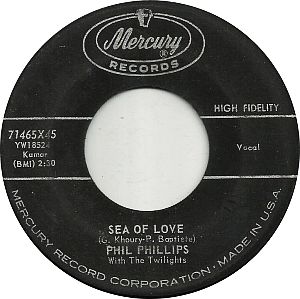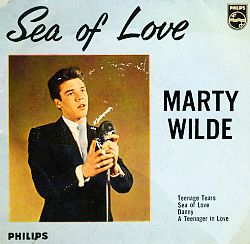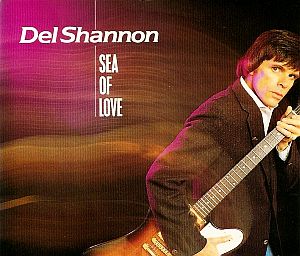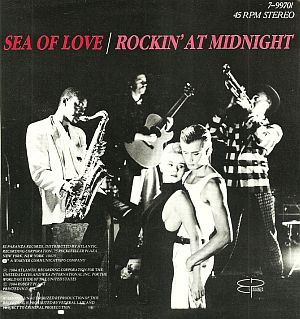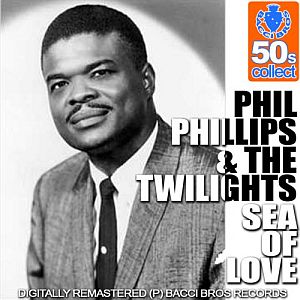
Cover art for “Sea of Love” by Phil Phillips & The Twilights, 1950s Collection, Bacci Bros Records, 2010. Click for digital.
“If only I could take her to the sea and tell her how much I love her, it would prove my love for her,” he would later recall. “With guitar in hand, a melody came to me as I started to strum. I started singing the melody out loud: ‘Come with me, my love…To the sea, the sea of love…I want to tell you how much I love you’.”
And with that, John Phillip Baptiste – who would later change his name to Phil Phillips – had the basis of a 1959 Top Ten hit song titled “Sea of Love.” It would eventually sell more than 2 million copies and win a gold record. But success for Phil Phillips with this song didn’t come easy, and his career suffered along the way as a contract dispute between feuding record labels prevented him from recording while he was a hot commodity.
Born John Phillip Baptiste on March 14, 1926, in Lake Charles, Louisiana, Phil Phillips began singing at the age of eight. As he grew a bit older he formed a gospel music group with his brothers called The Gateway Quartet. He also sang solos at his church. Phillips was also briefly enrolled at the Naval Academy in Annapolis, Maryland, but later returned to Lake Charles, Louisiana where he worked as a bellhop at the Chateau Charles Hotel. He later organized a group to sing backup which he named The Twilights. Phillips had also made a demo of his Verdie Mae/“Sea of Love” song. One afternoon, a gas company meter man heard him singing the song and told him he had a hit. The workman had also mentioned the song to George Khoury, who owned a record store and was also a local record producer. In 1958, Phillips was introduced to Khoury, who would soon record Phillips’ song at the Goldband Recording Studio, owned by Eddie Shuler.
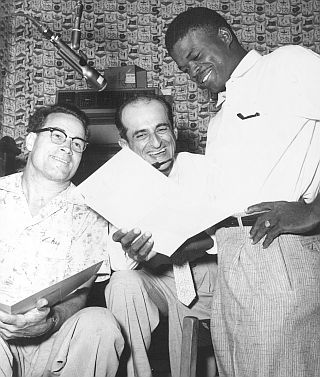
Eddie Shuler, George Khoury, and Phil Phillips at Goldband Studio, 1959, where “Sea of Love” was first recorded.
Music Player
“Sea of Love” – Phil Phillips
1959
Shuler was convinced the song was a hit the first time he heard it, listening to a demo that Phillips had made, recorded alone with his guitar. “You’re walking around with a million dollars in your hand,” Shuler would tell Phillips at one point, referring to the demo he heard.
Khoury first brought Phillips in for an audition in late February 1959, as he and Shuler worked out their production agreement. The song was arranged and produced by Eddie Shuler for George Khoury’s self-named label, Khoury Records.
Shuler and Khoury took some time to set the song’s arrangement, as Phillips with guitar began working with pianist Ernest Jacobs, and then with backing vocal groups. After three months they felt they were ready to record.
As Phil Phillilps would later recount: “The Twilights and I, along with some musicians and a group called Cookie & The Cupcakes, recorded Sea of Love in about eight to ten takes…” Phillips used the same exact lyrics that he had sung to Verdie Mae on her porch back in 1957. Cookie & the Cupcakes, was a local “swamp rock band” who had recorded their own song, but added background vocals and harmony for the session.
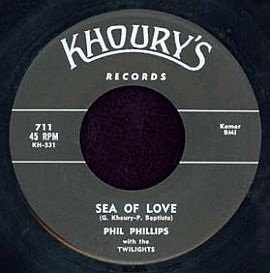
The “Sea of Love,” by Phil Phillips, as first issued by Khoury’s Records of Louisiana.
A deejay in Baton Rouge, however, played “Sea of Love” and his listeners liked it so much they started calling him to play it over and over. But the manager at that radio station wasn’t exactly smitten by the song, and told the deejay to quit playing it. When the deejay refused, they fired him.
Still, the deejay persisted, locking himself in the control room and playing the song repeatedly. That act of defiance did the trick for Phil Phillips and the “Sea of Love,” as the listening public began requesting the song. Other deejays also began playing it as well.
Khoury, meanwhile, negotiated a distribution deal with Mercury Records. Mercury leased the song and signed Phil Phillips to a contract. And all was well – but only for a time.The “Sea of Love” entered the Billboard pop chart at No. 85 in early July 1959. Phillips then appeared on American Bandstand’s second anniversary show on August 6, 1959 performing his hit, “Sea of Love.” Annette Funicello also appeared on that show performing the song “Lonely Guitar.” In addition to Bandstand, Philips also appeared on the Alan Freed Show that year. By late August, “Sea of Love” had risen to its peak No. 2 position on the Billboard pop chart.
In October 1959, Phillips joined the Dick Clark’s Caravan of Stars, touring the country with the Drifters, the Skyliners, Bobby Rydell, LaVern Baker, Duane Eddy, Paul Anka, Lloyd Price and others. It was around this time, that “Sea of Love” hit No. 1 hit on the R & B chart.
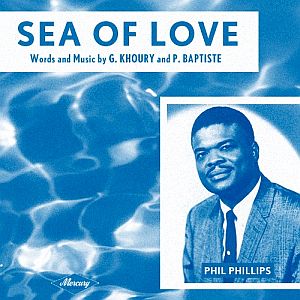
Cover of the 1959 record sleeve for the Mercury Records’ release of “Sea of Love
“They just put the kill on my records,” he would later say. “They had me under a five-year contract and I couldn’t get out of it and that killed my whole career.”
Phillips had also recorded enough material for an album, but he decided not to produce one under the circumstances.
In the late ‘60s, Phillips attempted a recording comeback at the Muscle Shoals recording studio in Sheffield, Alabama, where Percy Sledge had launched his career in 1966. But the Muscle Shoals experience didn’t help Phillips get back on track. Still, “Sea of Love,” both in Phillips’ version and some cover versions, would continue to get air time in subsequent years, helping to keep the song’s legacy alive.
Cover Versions
“Sea of Love” has been covered by a number of recording artists, including B. J. Thomas, Freddy Fender, the Heptones, Cat Power, Iggy Pop, Tom Waits and others. However, there were at least three cover versions of “Sea of Love” that reached the charts. One of the first of these came quickly on the heels of the original 1958 version – recorded in the U.K. by a rock ‘n roll star named Marty Wilde who was also popular on U.K. TV music shows.From mid-1958 to the end of 1959, Wilde was one of the leading British rock ‘n roll singers, along with Tommy Steele and Cliff Richard. In February 1959 Wilde had Top Ten hits with a cover version of Ritchie Valens’ hit “Donna” and in May that year with Dion DiMucci’s “A Teenager in Love.” Wilde’s version of “Sea of Love” became a No. 3 hit in the U.K. in September 1959. In more recent years, some of Wilde’s children including Ricky Wilde, Kim Wilde and Roxanne Wilde have had pop hits as well.
In 1982, Phil Phillips’ “Sea of Love” was covered by Del Shannon, and his version would climb to No. 33 on the pop charts.
Shannon’s version of the song had first entered Billboard’s Hot 100 chart on December 6th, 1981. About six weeks later, on January 16th 1982, Shannon performed “Sea of Love” on the ABC teen dance TV program, American Bandstand. A week later, by January 31st, 1982, the Shannon version peaked at No. 33.
For Shannon – who had three Top 10 hits in the 1960s, the most notable of which was his 1961 No.1, “Runaway” – it would be his 17th and last recording to enter the Top 100 chart.
Two years later, in 1984, a group named The Honeydrippers recorded “Sea of Love.” This group was a pet project of Robert Plant of the rock group Led Zeppelin, who wanted to have an R&B band.
In addition to Plant, The Honeydrippers group included Led Zeppelin’s Jimmy Page, Yardbirds alumnus Jeff Beck, Nile Rodgers from the band Chic, and Paul Shaffer on keyboards — this last participant known to many as the band leader on Late Night with David Letterman.
The Honydrippers version of “Sea of Love” rose to No. 3 on the pop chart, spending 14 weeks in the Top 40. In production of the single, the A-side was initially intended to be “Rockin’ At Midnight,” a cover of Elvis Presley’s “Good Rockin’ Tonight,” with “Sea of Love” as the B-side. But the single got flipped, which worked to the advantage of “Sea of Love.”
Another artist who has done a cover version of “Sea of Love” is Tom Waits who included it on his 2006 collection Orphans: Brawlers, Bawlers & Bastards. For Phil Phillips, meanwhile, the cover versions brought in some writer’s royalties, which helped keep him afloat through those years, as did a few uses of the song in films.
Al Pacino Film
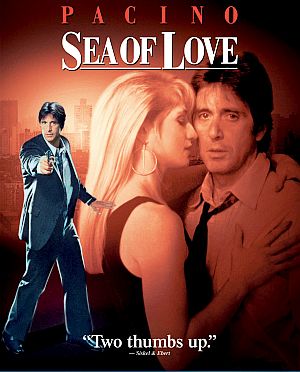
Blue-ray disc cover for the 1989 film, “Sea of Love,” starring Al Pacino, Ellen Barkin, and John Goodman. Click for DVD.
Frank is assigned the case, and investigates the murder of a man in Manhattan, found shot dead in his bed, face down and naked. The victim had been listening to an old 45 rpm recording of “Sea of Love,” which is still playing at the murder scene. Other victims are subsequently found murdered in the same way, some with the “Sea of Love” playing on the phonograph when the victim is found. A female perpetrator is suspected in the murders, and Frank sets about using his own singles ads to lure a series of females, one of whom he becomes involved with. Turns out, her ex-husband is the culprit, methodically killing the guys his former wife – and Frank’s new friend – had relationships with. Now Frank is next. When the murderous ex-husband comes to kill Frank, the two begin a fight, during which the perpetrator falls through a window and to his death. End of story.
In addition to the use of the Phil Phillips version in the Pacino film, “Sea of Love,” sung by Cat Power, was also used in the 2007 award-winning film Juno, the Canadian-American comedy-drama starring Ellen Page as the independent-minded teenager who confronts an unplanned pregnancy and more.
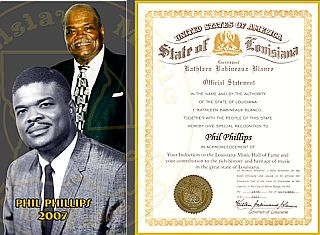 Phil Phillips in 2007 at his Louisiana Music Hall of Fame designation with statement signed by the Governor. |
Phil Phillips
Although Phil Phillips would not again reach the top of the music charts with his music, he would continue to perform occasionally and also work in the music business. In his later years, Phillips worked as a radio DJ at station KJEF in Jennings, Louisiana.
In October 2007, Phillips was honored for his contributions to Louisiana music with his induction into The Louisiana Music Hall of Fame. And in 2008, a compilation album under the title Sea of Love, was issued by the Bear Family Records. The CD contains some 26 tracks, including all of Phillips’ original Khoury/Mercury recordings, plus nine never released tracks and a 36-page booklet. Among the Phil Phillips tunes and covers included are: “Stormy Weather,” “Don’t Leave Me,” “I Love to Love You,” “Don’t Cry Baby,” and “Yes I’ll Get By.”
Phil Phillips, by the way, did not end up with Verdie Mae, which he seems to believe was for the best. Instead, he married Winnie Bell in June 1961, with whom he had seven children. The couple in recent years lived in Lake Charles, Louisiana. For additional stories at this website on music history please see the “Annals of Music” category page. Also included at this website, are stories on Dick Clark and American Bandstand and Alan Freed, both mentioned in the current story.
Thanks for visiting – and if you like what you see here, please make a donation to help support the research and writing at this website. Thank you. – Jack Doyle
|
Please Support Thank You |
____________________________________
Date Posted: 21 March 2015
Last Update: 11 July 2022
Comments to: jdoyle@pophistorydig.com
Article Citation:
Jack Doyle, “Sea of Love, 1959,”
PopHistoryDig.com, March 21, 2015.
____________________________________
Sources, Links & Additional Information
|
“Top 25 Hit Songs” 1. The Three Bells -The Browns |
“Phil Phillips / Bio,” ReverbNation.com.
“Phil Phillips,” Wikipedia.org.
Goldband Records: The Early Years (Update) Wired For Sound, Thursday, November 24, 2011.
“Sea of Love (song),” Wikipedia.org.
Stephen Thomas Erlewine, “Review of Sea Of Love (album),” AllMusic.com, Bear Family Records, 2008.
“Sea of Love by Phil Phillips with the Twilights,” SongFacts.com.
“Sea of Love (film),” Wikipedia.org.
“Phil Phillips,” The Louisiana Music Hall of Fame, October 2007.
Rick Coleman, CD liner notes, Phil Phillips, Sea Of Love, Bear Family CD, 2008.
“The Hot 100,” Billboard, Week of September 5, 1959.
“Phil Phillips,” Black Cat Rockabilly (website).
Fred Bronson, “The Top 100 Songs of 1959,” Billboard’s Hottest Hot 100 Hits, 4th edition, New York: Billboard Books, 2007, p. 339.
Joel Whitburn, “Phil Phillips with The Twilights,” The Billboard Book of Top 40 Hits, Revised and Expanded Eighth Edition, New York: Billboard Books, 2004, p. 491.
_________________________________
